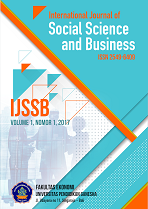Financial Distress of Multi-Finance Companies in Emerging Markets
DOI:
https://doi.org/10.23887/ijssb.v8i4.86349Keywords:
Financial Distress, Multifinance Companies, Merton Model, Internal and External Variables of the CompanyAbstract
Financial distress is when the company cannot pay what has been agreed upon when it is due. This paper discusses financial difficulties in multi-finance companies from 2010 to 2023. Forecasting financial difficulties uses the Merton Model method, adapted from the Black-Scholes Model for option prices. The method used to predict financial difficulties for multi-finance companies uses the Merton Method, as described previously, which is an adaptation of the Black-Scholes method. His research found that multi-finance companies still have negative interest margins. Increasing the credit disbursed also needs to receive attention from company management. The company's marketing costs also appear minor and can be imitated by other institutions. The probability of financial distress for multi-finance companies is very high and cannot be separated from the business characteristics of multi-finance companies. Multifinance companies still have negative interest margins. Increasing the credit disbursed also needs to receive attention from company management; the company's marketing costs also appear minor and can be imitated by other institutions; the probability of financial distress for multi-finance companies is very high and cannot be separated from the business characteristics of multi-finance companies.References
Afik Z, Arad O, Galil K. (2016). Using Merton Model for Default Prediction: An Empirical Assessment of Selected Alternatives. Journal of Empirical Finance, 35:43-67. https://doi.org/10.1016/j.jempfin.2015.09.004
Ahmadi A, Soleimani B, Vaghfi B, Hesam S, Salimi, M. B. (2012). Corporate Bankruptcy Prediction Using a Logit Model: Evidence from Listed Companies of Iran. World Applied Sciences Journal, 17(9):1143-1148.
Ali K, Akhtar M. F, Ahmed H. Z. M. F. (2011). Bank-Specific and Macroeconomic Indicators of Profitability-Empirical Evidence from the Commercial Banks of Pakistan. International Journal of Business and Social Science, 2(6): 235–242. https://www.researchgate.net/
Altman, E. I. (1968). Financial Ratios, Discriminant Analysis and the Prediction of Corporate Bankruptcy. Journal of Finance 23:589-609. https://doi.org/10.1111/j.1540-6261.1968.tb00843.x
Altman, E. I., Avery, R. B., Esienbeis, R. A. J. E., Sinkey. (1981). Application of Classification Techniques in Business Banking and Finance. Stamford City (US): Jai Press Inc.
Analytica, O. (2021). "China's New Bankruptcy Rules Will Lift Economic Growth," Expert Briefings. https://doi.org/10.1108/OXAN-DB263763
Ariani R, D. N., & Danarsari. (2021). Analysis of Determination on the Efficiency of Multifinance Companies in Indonesia, International Journal of Islamic and Social Science. 1(2): 20 – 27.
Beaver W. (1966). Financial Ratios as Predictors of Failures. Journal of Accounting Research 4(Supplement): pp. 71–102. https://doi.org/10.2307/2490171
Betz O, Peltonen A, & Sarlin B. (2014). Predicting Distress in European Banks, Journal of Banking & Finance 45, 225 -241. https://doi.org/10.1016/j.jbankfin.2013.11.041
Bharat, S., & Shumway, T. (2008). Forecasting Default with the Merton Distance to Default Model. Review of Financial Studies, 21 (3): 1339–1369. https://doi.org/10.1093/rfs/hhn044
Black, F. M. S. (1973). The Pricing of Options and Corporate Liabilities. Journal of Political Economy. 81 (3): 637 – 654. https://doi.org/10.1086/260062
Crosbie, P. J. B. (2003). Modeling Default Risk, KMV Corporation, USA
Fletcher, D. E. G. (1993). Forecasting with Neural Networks: An Application Using Bankruptcy Data. Inform Manage. 24(3):159–167. https://doi.org/10.1016/0378-7206(93)90064-Z
Hesse, H., & Poghosyan, T. (2009). Oil Prices and Bank Profitability: Evidence from Major Oil-Exporting Countries in the Middle East and North Africa. International Monetary Fund, IMF Working Papers. https://doi.org/10.5089/9781451873672.001
Hesse, H., & Poghosyan T. (2016). Oil Prices and Bank Profitability: Evidence from Major Oil-Exporting Countries in the Middle East and North Africa. IMF Working Paper. In Chapter 12A. https://doi.org/10.1057/978-1-137-52246-7_12
Hillegeist, S. A., Elizabeth, K., Donald, P., Cram, J. G. L. (2004). Assessing the Probability of Bankruptcy. Review of Accounting Studies 9, 5–34. https://doi.org/10.1023/B:RAST.0000013627.90884.b7
Kaur, J. (2018). Financial Distress Identification: Application of Black-Scholes – Merton Model, Journal of Commerce & Accounting Research 7 (2):44 -55
Kristianti, R. A. (2016). Factors Affecting Bank Performance: Cases of Top 10 Biggest Government and Private Banks in Indonesia in 2004-2013. Review of Integrative Business and Economics Research, 5(4):371-378
Manurung, A. H. (2008). Probabilitas Default Perusahaan, The Ary Suta Center on Strategic Management; Juli 2008; pp. 7 – 22. Jakarta (ID): The Ary Suta Center.
Manurung, A. H. (2012). Teori Keuangan Perusahaan. Jakarta (ID): PT Adler Manurung Press.
Manurung, A. H, Hutahayan, B. K., Deniswara. (2020). Probability of Bankruptcy of Coal Mining Firm in Indonesia, International Journal of Advanced Science and Technology, 29(5):8785-8799.
Manurung, A. H., & Kartika, T. R. (2020). Loan Deposit Ratio of Indonesia Bank: Speed Adjustment? International Journal of Advanced Science and Technology. 29 (4):6065 – 6074.
Manurung, A. H., Usman, B., & Manurung, J. C. (2020). Determinants of RAROC of Bank Using Internal and External Bank Factor and Size as Moderating Variable. International Journal of Advanced Science and Technology. 29 (4):3433 – 3441.
Manurung, A. H., Tjahyana, D., Pangaribuan, C. H., M. E., & Tambunan. (2022). Metode Riset: Akuntansi, Investasi, Keuangan dan Manajemen. Jakarta (ID): PT Adler Manurung Press.
Manurung, A. H. (2023). Kebangkrutan Perusahaan: Proses, Metodologi dan Valuasi. Jakarta (ID): PT Adler Manurung Press.
Manurung, A. H. (2024). Regression and Extension: Cross-Section and Time Series Data. Jakarta (ID): PT. Adler Manurung Press.
Mayliza, C. S., Manurung, A. H. B., Hutahayan. (2020). Analysis of the Effect of Financial Ratios to Probability Default of Indonesia’s Coal Mining Company, Journal of Applied Finance & Banking, 10(5):167-179.
Merton, R. C. (1974). On the Pricing of Corporate Debt: The Risk Structure of Interest Rates, Journal of Finance, 29 (2):449–470. https://doi.org/10.1111/j.1540-6261.1974.tb03058.x
Odom, M., & Sharda R. (1990). A Neural Network for Bankruptcy Prediction. International Joint Conference on Neural Networks, 2:163-168. https://doi.org/10.1109/IJCNN.1990.137710
Ohlson, J. A. (1980). Financial Ratios and the Probabilistic Prediction of Bankruptcy. Journal of Accounting Research, 18:109-131. http://dx.doi.org/10.2307/2490395
Outecheva, N. (2007). Corporate Financial Distress: An Empirical Analysis of Distress Risk. [Unpublished Doctorate Dissertation]. Washington DC (US): University of St. Gallen.
O’Connell, M. (2023). Bank-Specific, Industry-Specific and Macroeconomic Determinants of Bank Profitability: Evidence from the UK. Studies in Economics and Finance, 40(1). https://doi.org/10.1108/SEF-10-2021-0413
Pangaribuan, P. M. A. V., & Purba. (2023). Pemodelan Probability of Default Portofolio Pembiayaan Bersama Fintech Lending dan Multi Finance: Studi Kasus Bank ABC. Oikos: Jurnal Kajian Pendidikan Ekonomi dan Ilmu Ekonomi, 7(2): 562- 576.
Pasaribu, P., Tobing, W., & Manurung, A. H. (2009). Estimasi Probabilitas Default Perusahaan dan Hubungannya Dengan Rasio Keuangan, Finance and Banking Journal, 11(1):50 - 60.
Platt, H. D., & Platt, M. B. (2002). Predicting Corporate Financial Distress: Reflection on Choice-Based Sample Bias, Journal of Economic and Finance, 26(2):184 – 199. https://doi.org/10.1007/BF02755985
Pranowo, K., Achsani, N. A., Manurung, A. H., & Nuryartono N. (2010). Determinant of Corporate Financial Distress in an Emerging Market Economy: Empirical Evidence from the Indonesian Stock Exchange 2004-2008. International Research Journal of Finance and Economics.28(2):109-113.
Setiadi, D. (2024), Determinan Financial Distress Perusahaan Mutifinance 2010 – 2023, Disertasi tidak dipublikasikan Institut Pertanian Bogor.
Scott, J. (1981). The Probability of Bankruptcy: A Comparison of Empirical Predictions and Theoretical Models, Journal of Banking and Finance, 5(3):317 – 344. https://doi.org/10.1016/0378-4266(81)90029-7
Sundaresan, S. (2013). A Review of Merton’s Model of the Firm’s Capital Structure with its Wide Application, Annual Review of Financial Economics, 5:21–41. https://doi.org/10.1146/annurev-financial-110112-120923
Suwandi, N. G., W. N., & Dewi. (2023). Design and Build Credit Analysis Applications for Multi-Finance Companies. Jurnal Teknik Informatika dan Sistem Informasi (JATISI), 10(2):1 – 17.
Tudela, M. G. & Young. (2003). A Merton-Model Approach to Assessing the Default Risk of UK Public Companies, Bank of England Working Paper Series No. 194. https://doi.org/10.2139/ssrn.530642
Utami, T. S., & D. I Purnamasari. (2023). The Impact of Financial Ratios and Economic Value Added (EVA) on the Firm Value of Multi-Finance Companies Listed on BEI (Indonesian Stock Exchange) in 2015-2021. Journal of Economics, Finance and Management Studies (JEFMS), 6(3):1387 - 1391.
Whitaker, R. B. (1999). The Early Stages of Financial Distress. Journal of Economics and Finance, 23:123-133. https://doi.org/10.1007/BF02745946
Wibowo, B. (2017). Probability of Default, Interest Margin and Bank Efficiency; Empirical Test of Merton Model in Indonesian Banking, Journal of Applied Management, 15(2):219 – 228. https://doi.org/10.21776/ub.jam.2017.015.02.05
Widyastuti, U., Purwana, D., Zulaihati, S. (2017). Internal Determinants of Commercial Bank Profitability in Indonesia. Mediterranean Journal of Social Sciences MCSER Publishing, Rome-Italy. 8 (3):219-223. https://doi.org/10.5901/mjss.2017.v8n3p219
Wilson, R. L., & Sharda, R. (1994). Bankruptcy Prediction Using Neural Networks. Decision Support Systems, 11:545-557. https://doi.org/10.1016/0167-9236(94)90024-8
Wruck, K. H. (1990). Financial Distress, Reorganization, and Organizational Efficiency. Journal of Financial Economics, 27:419 – 444. https://doi.org/10.1016/0304-405X(90)90063-6
Xu, C, & Xie, B. (2015). The Impact of Oil Price on Bank Profitability in Canada. Pp 1–38. Burnaby (CA): Simon Fraser University.
Zmijewski, M. E. (1984). Methodological Issues Related to The Estimation of Financial Distress Prediction Models; Journal of Accounting Research. 22:59 – 82. https://doi.org/10.2307/2490859
Downloads
Published
How to Cite
Issue
Section
License
Copyright (c) 2024 Dharma Satriadi, Hermanto Siregar, Adler Haymans Manurung, Nimmi Zulbainarni

This work is licensed under a Creative Commons Attribution-ShareAlike 4.0 International License.










